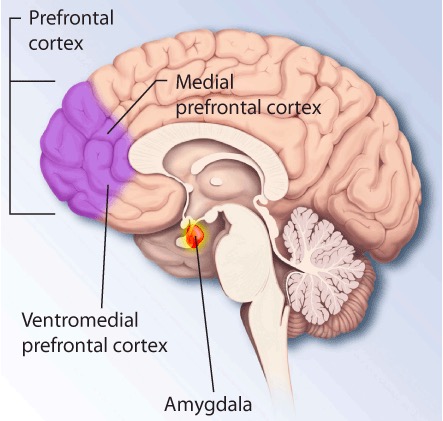Playlist
Show Playlist
Hide Playlist
Post-Traumatic Stress Disorder (PTSD)
-
Slides PTSD Psychiatry.pdf
-
Download Lecture Overview
00:01 Posttraumatic stress disorder, otherwise known as PTSD. 00:06 Let’s start off by looking at the case of Jim to put things into context. 00:11 Jim is a 54-year-old combat veteran. 00:14 He spends most of his time at home and avoids gatherings with more than only a few people. 00:20 When he went to his niece’s birthday party, he started sweating, felt nervous and became paranoid when a balloon popped. 00:29 Jim had to immediately go home because he felt unsafe. 00:33 That night, he had vivid nightmares about his time in combat and woke up in a cold sweat. 00:41 Well, how would you define posttraumatic stress disorder? PTSD is a severe, often chronic and disabling disorder, which develops in some persons following exposure to a traumatic event involving actual or threatened injury to themselves or others. 01:02 Symptoms lead to considerable social occupational and interpersonal dysfunction. 01:11 What types of risk factors lead to PTSD? Well, here are a couple. 01:16 Sexually violent relationships such as rape or childhood sexual abuse, intimate partner violence can all contribute. 01:26 So can interpersonal network traumatic experiences. 01:32 Things like unexpected death of a loved one, a life-threatening illness of a child, or a traumatic event in a loved one. 01:40 And also interpersonal violence. 01:43 Again, childhood abuse or witnessing violence in the home, physical assault or being threatened by someone. 01:51 Exposure to organized violence like refugees, being kidnapped or civilian in a warzone. 01:58 And participation in organized violence, whether this is combat exposure, being in a gang, and other things as well. 02:07 Things like being in a car accident, exposed to some toxic or chemical. 02:14 The lifetime prevalence of PTSD ranges from 7 to 12% in the general adult population in the United States. 02:24 Let’s go back to the story of Jim. 02:26 So Jim became very distressed by his nightmares, intrusive thoughts and inability to tolerate family functions without becoming triggered, paranoid, and upset. 02:37 He was severely injured in combat and suffers chronic pain for which he was given disability. 02:44 Since he’s no longer working, he spends his time at home and is gradually becoming very isolated. 02:51 So Jim comes to you, he comes into your office for a psychiatric evaluation in the hopes of getting some help so he can engage more with his family. 03:01 What questions would you ask in your assessment of Jim for PTSD? “Tell me about your experience in combat.” “What was your experience of danger during your time serving in the war?” You really want to revisit potential triggers to help change emotional responses to his memories. 03:23 Ask “How did you initially respond to recognition that you were in grave danger during war?” And what emotions were associated with your experience? Jim tells you that at first, he was excited to travel with his peers to fight and defend his country. 03:42 There was great sense of unity within his troop and he made many friends quickly. 03:47 Then things got serious and his troop rolled over an IED, an explosive device, which exploded and he saw his best friend lose a leg. 03:58 Jim’s physical integrity was not harmed, but he had excruciating back pain since that explosion and he can’t get the image of his friends losing his limbs out of his mind. 04:12 Jim felt intense fear and hopelessness during the event. 04:18 Sometimes, he thinks he went numb and everything felt unreal. 04:24 This makes him feel guilty because he wishes he would’ve been able to react and help his troop, maybe even protect his friend. 04:32 What else would you ask Jim to assess his current state of well-being? What else would you ask Jim to assess his current state of well-being? “How did you find yourself reexperiencing the event?” Be curious about dreams, flashbacks and intrusive recollections. 04:53 What people, places and events are being avoided in the present time? Be attentive here to signs of isolation, avoidance of social and occupational gatherings. 05:06 Be aware of secondary conditions as a result of this. 05:10 For example, you might inquire if Jim is feeling depressed from social isolation and loneliness as well as from chronic disability and pain. 05:20 How do you respond in situations when feeling triggered? Be attentive to the following: Any limited range of affect from Jim, feelings of detachment or estrangement. 05:34 And how often do you feel hyperaroused? Pay attention to whether or not Jim is having sleeping difficulties, outbursts of anger or an exaggerated startle response? Persistent exaggerated negative beliefs are common in PTSD. 05:50 Someone like Jim might say things like “I am all bad,” “No one can be trusted,” “The world is complete dangerous,” or “My whole nervous system is completely and permanently ruined.” When diagnosing PTSD, note the persistence of symptoms has to be for at least four weeks following the trauma, but most patients will present for treatment many, many months, sometimes years later. 06:24 Now, when diagnosing PTSD, all of the following criteria must be met. 06:30 There has to an exposure to actual or threatened death, serious injury, or sexual violence. 06:36 Intrusive symptoms related to the trauma, persistent avoidance of stimuli associated with the traumatic events, negative alterations in cognition and mood associated with the traumatic events. 06:51 There has to marked alterations and arousal and reactivity associated with the trauma. 06:58 The duration of the disturbance has to be for more than one month and the disturbance causes clinically significant distress that affects social functioning. 07:09 Finally, a diagnosis of PTSD is only possible when you’ve ruled other medically conditions and substance use issues as well as other psychiatric disorders. 07:21 When assessing trauma in children, it’s important to note that children older than 6 years old will engage in repetitive play that will mimic themes or aspects of the witnessed or experienced trauma. 07:37 In children, there may be frightening dreams without any recognizable content. 07:43 So remember, a child may not be able to directly link their dream to the trauma, but be attentive to whether or not they’re having nightmares. 07:52 What are some of the subtypes of PTSD? You want to know whether or not it’s with or without dissociative symptoms such as depersonalization and derealization. 08:04 Also, whether or not the PTSD is with delayed expression. 08:08 For example, full diagnostic criteria are not met until six months or beyond. 08:15 Let’s define depersonalization and differentiate it from derealization. 08:20 Depersonalization is a persistent recurrent experience of feeling detached from as if one were an outside observer of one’s mental process or body. 08:33 For example, feeling as though one were in a dream, feeling as though they’re not in reality or like time is moving slowly. 08:42 Derealization is the persistent or recurrent experience of unreality of the surroundings. 08:49 For example, the world around the individual is experienced as unreal, dreamlike, distant or distorted somehow.
About the Lecture
The lecture Post-Traumatic Stress Disorder (PTSD) by Helen Farrell, MD is from the course Anxiety and Stress-Related Disorders. It contains the following chapters:
- Post Traumatic Stress Disorder
- How to Diagnose PTSD?
Included Quiz Questions
Which of the following best defines post-traumatic stress disorder (PTSD)?
- Severe, chronic, and disabling disorder following exposure to a traumatic event.
- Mild and acute disorder following exposure to a traumatic event.
- Severe episodes of palpitations, sweating and high blood pressure due to high epinephrine.
- Several blank staring episodes with no loss of consciousness.
- Severe acute disabling disorder leading to considerable social and interpersonal dysfunction.
Which of the following is NOT a risk factor for post-traumatic stress disorder (PTSD)?
- Childhood seizures
- Intimate partner violence
- The unexpected death of loved ones
- Motor vehicle collision
- War and armed conflicts (combat exposure)
The following statements about post-traumatic stress disorder (PTSD) are true, EXCEPT:
- Lifetime prevalence ranges from 50%-60% in the general population.
- It can occur due to physical assault.
- Symptoms lead to considerable social, occupational and interpersonal dysfunction.
- The patient can experience vivid nightmares related to the event.
- The patient can experience intense fear and hopelessness during the event.
When interviewing a patient with likely post-traumatic stress disorder (PTSD), all of the following must be asked to assess the patient’s current mental health, EXCEPT?
- Genetic history
- Flashbacks and intrusive recollection
- Signs of isolation and occupational gatherings
- Feelings of detachment/estrangement
- Sleeping difficulties
Which of the following is NOT a diagnostic criterion of post-traumatic stress disorder (PTSD)?
- The duration of disturbance must be more than 1 year.
- Exposure to actual or threatened death, serious injury or sexual violence.
- Persistence avoidance of stimuli associated with the traumatic events.
- Marked alterations in arousal and reactivity with the traumatic event.
- Not related to other medical, substance or psychiatric condition.
Which of the following terms corresponds to a sense of unreality of self, detachment from the body or a feeling being an outside observer in one's own life?
- Depersonalization
- Derealization
- Desensitization
- Demoralization
- Decortication
Customer reviews
5,0 of 5 stars
| 5 Stars |
|
5 |
| 4 Stars |
|
0 |
| 3 Stars |
|
0 |
| 2 Stars |
|
0 |
| 1 Star |
|
0 |




